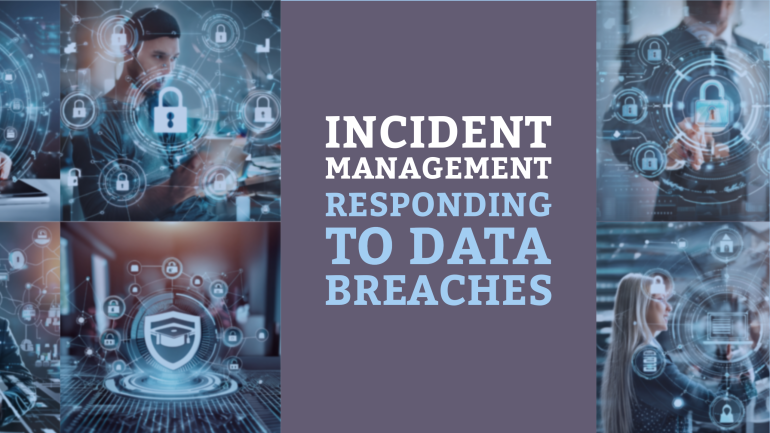Table of Contents
TL;DR: Incident Management – Responding to Data Breaches
- Preparation is Key: Having a well-defined incident response plan in place can significantly reduce the impact of a data breach.
- Swift Response: Timely detection and response to a data breach can help contain the damage and prevent further loss of data.
- Communication is Crucial: Transparent and clear communication with stakeholders, customers, and regulatory authorities is necessary during a data breach incident.
- Forensic Investigation: Conducting a thorough forensic investigation can help identify the root cause of the breach and prevent future incidents.
- Learning from Incidents: Analyzing past breaches can provide valuable insights to enhance security measures and strengthen the incident response process.
Breach incidents and data breaches have become a common occurrence in today’s digital world, posing a significant threat to organizations’ sensitive information. Responding promptly and effectively to these breaches is crucial to minimizing the damage and protecting the affected data. In this blog post, we will discuss the key steps and best practices involved in incident management for responding to data breaches. Stay informed and safeguard your data with the insights shared here.
Understanding Data Breaches
Definition and Types of Data Breaches
A data breach is the unauthorized access, use, or disclosure of sensitive information. There are various types of data breaches, including phishing attacks, malware infections, insider threats, physical theft, and human error. It is crucial for organizations to be aware of the different types of data breaches to effectively respond and prevent them.
| 1. Phishing attacks | 4. Physical theft |
| 2. Malware infections | 5. Human error |
| 3. Insider threats |
Common Causes of Data Breaches
With the increasing reliance on digital systems, data breaches have become more prevalent. Common causes of data breaches include weak passwords, lack of encryption, outdated software, employee negligence, and third-party vulnerabilities. Organizations must address these vulnerabilities to enhance their cybersecurity posture and protect sensitive information.
Preparation and Prevention
Developing an Incident Response Plan
The first step in preparing for a data breach is to develop an incident response plan. This plan outlines the steps that will be taken in the event of a security incident, ensuring a swift and coordinated response to minimize damages and restore operations as quickly as possible. Prevention is always the best strategy, but having a solid plan in place can significantly reduce the negative impact of a breach.
Implementing Security Measures to Prevent Breaches
For effective prevention of data breaches, implementing robust security measures is crucial. This includes regular security assessments, employee training on cybersecurity best practices, encryption of sensitive data, and strict access controls. Strong access controls can reduce the risk of unauthorized access, while encryption adds an extra layer of protection to data, making it unreadable to unauthorized users.
Response to security incidents requires a thorough understanding of the organization’s network, systems, and data flows. When a breach is detected, immediate action is crucial to contain the incident and prevent further damage. A well-prepared response team and clear communication channels can minimize the impact of a data breach and ensure a swift recovery.
The Incident Response Process
Initial Response to a Data Breach
Your first step in the incident response process is to have a well-defined plan in place to guide your actions when a data breach occurs. This plan should include clear roles and responsibilities for each team member involved in the response.
Investigation and Containment
Any suspected or confirmed data breach requires immediate investigation and containment. This involves gathering evidence to determine the extent of the breach, identifying the cause, and taking steps to prevent further damage.
It is crucial to act swiftly and decisively during the investigation and containment phase to minimize the impact of the breach and protect sensitive data from unauthorized access.
Eradication and Recovery
Eradication and recovery involve removing the threat from your system, restoring impacted data, and implementing additional security measures to prevent future breaches. This phase aims to return your systems to a secure and functional state.
Containment of the breach is vital to prevent further damage and limit the exposure of sensitive information to unauthorized parties.
Notification and Communication Strategies
With any data breach, transparent and timely communication is crucial. Notify affected parties, such as customers and stakeholders, about the breach, its impact, and the steps being taken to address the situation. Establish clear lines of communication to provide updates and address concerns.
Incident response teams should work closely with legal counsel and public relations professionals to ensure that communication is compliant with regulations and helps maintain trust in your organization.
Post-Incident Analysis and Reporting
Investigation of a data breach should not end once the immediate threat is contained. Conduct a thorough post-incident analysis to identify weaknesses in your security measures, assess the effectiveness of your response plan, and develop strategies to prevent similar incidents in the future.
Breach reports should be shared with relevant stakeholders, including regulatory authorities, to demonstrate compliance and commitment to data protection.
Legal and Regulatory Considerations
Compliance with Data Protection Laws
Regulatory compliance with data protection laws is paramount when responding to data breaches. Organizations must ensure that they are following the requirements set forth by laws such as the GDPR, CCPA, or HIPAA. Failure to comply with these regulations can result in hefty fines and damage to the organization’s reputation. It is crucial to have a thorough understanding of these laws and incorporate them into the incident response plan.
Working with Law Enforcement and Regulatory Bodies
One of the critical steps in responding to a data breach is working with law enforcement and regulatory bodies. Cooperation with these entities can help in investigating the breach, apprehending the perpetrators, and minimizing the damage caused. It is important to establish a good working relationship with these authorities to facilitate a quick and effective response.
Another important aspect of working with law enforcement and regulatory bodies is maintaining transparency. Providing timely and accurate information to these entities can help in gaining their trust and support. Additionally, collaborating with them can result in valuable insights and resources to strengthen the organization’s security posture.
Summing up
The response to data breaches is a critical aspect of incident management that requires a well-structured and practiced plan to mitigate the impact on an organization. By swiftly identifying and containing the breach, communicating effectively with stakeholders, conducting thorough investigations, and implementing corrective actions, organizations can minimize damage and protect their reputation. Continuous improvement through post-incident analysis and learning from past incidents is crucial to enhancing incident response strategies. Being prepared and proactive in responding to data breaches is imperative in today’s digital landscape to safeguard sensitive information and uphold trust with customers and stakeholders.
FAQ
Q: What is a data breach?
A: A data breach is a security incident where sensitive, confidential, or protected information is accessed or disclosed without authorization.
Q: Why is incident management important for responding to data breaches?
A: Incident management is crucial for responding to data breaches because it helps organizations minimize the impact of the breach, mitigate further risks, and ensure a timely and effective response to protect sensitive information.
Q: What are the key steps in incident management for responding to data breaches?
A: The key steps in incident management for responding to data breaches typically include preparation, identification, containment, eradication, recovery, and post-incident analysis.
Q: How can organizations prepare for potential data breaches?
A: Organizations can prepare for potential data breaches by developing an incident response plan, conducting regular security assessments, implementing robust cybersecurity measures, and providing employee training on data security best practices.
Q: What should organizations do after experiencing a data breach?
A: After experiencing a data breach, organizations should immediately activate their incident response plan, contain the breach to prevent further exposure, notify affected individuals as required by law, work on eradicating the breach, recover any lost data, and conduct a post-incident analysis to learn from the incident and improve future response efforts.





